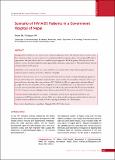Please use this identifier to cite or link to this item:
https://hdl.handle.net/20.500.14356/2025| Title: | Scenario of HIV/AIDS Patients in a Government Hospital of Nepal |
| Authors: | Poudel, B N Dhungana, G P |
| Citation: | PoudelB. N., & DhunganaG. P. (2011). Scenario of HIV/AIDS Patients in a Government Hospital of Nepal. Journal of Nepal Health Research Council. https://doi.org/10.33314/jnhrc.v0i0.236 |
| Issue Date: | 2010 |
| Publisher: | Nepal Health Research Council |
| Article Type: | Original Article |
| Keywords: | Clinical features Candidiasis Dhangadi HIV/AIDS Tuberculosis |
| Series/Report no.: | Oct, 2010;236 |
| Abstract: | Abstract Background: With the increase in the severity of immunosupression, due to HIV infection, there is increase in the flow of patients seeking care and support services. Antiretroviral drugs minimize chance of developing AIDS related opportunistic infection and therefore there would be the prolongation of life of the patients. The objectives of this study are to assess the chief complaints, major opportunistic infections, complications of ART and treatment outcome of hospital admitted HIV patients. Methods: A cross sectional study was carried out between December 2008 to May 2009 among 66 HIV patients undergoing indoor treatment in Seti Zonal Hospital, Dhangadhi. Results: Of the total cases, 36 (54.5%) were male and 30 (45.5%) were females with predominant age group of 31- 40 years (47%). About 24% of admitted patients had CD4 count less than 50/cu mm blood. Thirty five (53%) casespresented fever as the major clinical presentation of HIV/AIDS due to different opportunistic infections followed by cough (28.8%), loss of appetite (28.8%), weight loss (27.3%), and diarrhea (24.2%). Tuberculosis was found to be the major opportunistic infection accounting 27.3% followed by gastroenteritis (21.2%) and oral candidiasis (15.5%). Treatment outcome of hospital admitted patients showed the 83.3% recovery rate and 4.3% death rate. Conclusions: Hospital admission was found to be efficient to treat the major opportunistic infections and management of ART hypersensitivity reactions. While tuberculosis was the leading opportunistic infection, the most common clinical manifestation was found to be fever among the admitted HIV/AIDS patients. |
| Description: | Original Article |
| URI: | http://103.69.126.140:8080/handle/20.500.14356/2025 |
| ISSN: | Print ISSN: 1727-5482; Online ISSN: 1999-6217 |
| Appears in Collections: | Vol 8 No 2 Issue 17 October 2010 |
Files in This Item:
| File | Description | Size | Format | |
|---|---|---|---|---|
| 236-Article Text-234-1-10-20130822.pdf | Full Text Article | 194.26 kB | Adobe PDF |  View/Open |
Items in DSpace are protected by copyright, with all rights reserved, unless otherwise indicated.
